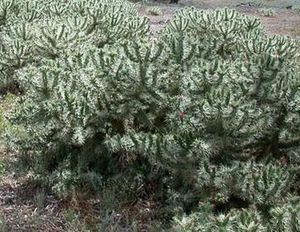Hudson pear facts for kids
Quick facts for kids Hudson pear |
|
|---|---|
 |
|
| Scientific classification | |
| Genus: |
Cylindropuntia
|
| Species: |
rosea
|
The Hudson pear (scientific name: Cylindropuntia rosea) is a type of cactus. It originally comes from the Sonoran Desert in Arizona, USA, and parts of northwestern Mexico. This plant is known for being an invasive species in Australia, which means it has spread widely there and causes problems.
Contents
What the Hudson Pear Looks Like
The Hudson pear has pretty pink flowers. It also has long, strong, white spines. These spines can be quite sharp! This cactus can grow very tall, up to 1.5 meters (about 5 feet) high. It can also spread out very wide, up to 3 meters (about 10 feet) across.
The Hudson pear looks a lot like another cactus called Cylindropuntia tunicata. That cactus also grows in the same areas. However, Cylindropuntia tunicata has yellow or straw-colored flowers, which helps tell them apart.
Why the Hudson Pear is a Problem in Australia
The Hudson pear was brought to Australia on purpose a long time ago. But it has become an invasive species there. This means it spreads very quickly and harms the local environment and farms. It is now considered a noxious weed, which is a plant that causes a lot of trouble.
How it Spread
The Hudson pear has spread from the opal fields around Lightning Ridge in New South Wales. It now covers a huge area, about 60,000 hectares (over 148,000 acres). You can find it around Lightning Ridge, Brewarrina, Broken Hill, Baradine, Coonamble, and Goodooga, New South Wales. It has also been found in Western Australia and Queensland.
The plant spreads easily because small pieces of its stems can break off. These pieces can attach to rubber tires on cars or even people's shoes. When these pieces fall off somewhere else, they can start growing into new plants. It's also possible that its fruits help it spread.
Dangers to Animals
The sharp spines of the Hudson pear are very dangerous for animals. Animals can get badly hurt if they touch or step on the plant. This can cause serious injuries to their feet or bodies.
Fighting the Spread
Scientists are looking into ways to control the Hudson pear using natural methods. This is called "biological control." It means using other living things, like insects, to stop the plant from growing too much.
Local groups, like the Lightning Ridge Miners Association, are helping too. They give out special sprays (herbicides) to miners. Miners use these sprays to control the plant where they live and work. Spraying has helped reduce the plant in the Lightning Ridge area. However, people need to keep spraying regularly to keep it under control. The government of New South Wales has spent a lot of money, about $200,000, to manage this problem weed.
See also
 In Spanish: Cylindropuntia rosea para niños
In Spanish: Cylindropuntia rosea para niños

